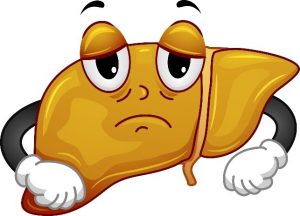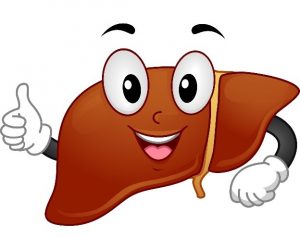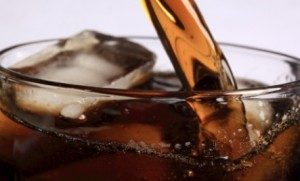Are Sodas Damaging Your Child’s Liver?
Author: Dr. Stephen Chaney
 Is reversing fatty liver disease possible?
Is reversing fatty liver disease possible?
Years ago, fatty liver disease was unheard of in children. Chronic liver disease in children was almost always caused by rare gene mutations. That was before the obesity epidemic. Obesity and overweight have increased two- to three-fold in our children and adolescents over the last two decades, and the incidence of non-alcoholic fatty liver disease has skyrocketed along with it.
Non-alcoholic fatty liver disease is now the leading cause of chronic liver disease in children and adolescents in the United States. It was found in 9.6% of all our children, 17.3% of our adolescents ages 15-19, and 38% of our children who are overweight or obese (JB Schwimmer et al, Pediatrics, 118: 1388-1393, 2006).
This is alarming because fatty liver disease increases the risk of developing type-2 diabetes, heart disease, cirrhosis of the liver, end stage liver disease, and liver cancer. If this epidemic of fatty liver disease in our adolescents is not reversed, we are condemning them to a lifetime of poor health.
Consumption of sodas and sugary processed foods is strongly associated with both obesity and fatty liver disease. That has led many experts to recommend we eliminate sodas, fruit juices, and sugary desserts and processed foods from our diet. However, associations do not prove cause and effect. Food manufacturers have claimed there was no proof these foods cause obesity and fatty liver disease.
That’s where a recent study performed at Emory University and the University of California at San Diego, (JB Schwimmer et al, JAMA, 321: 256-265, 2019) comes in. This study was a randomized clinical trial that asked whether elimination of soft drinks, fruit juices, and foods with added sugars from the diet of adolescents with fatty liver disease could reverse the disease.
This study has two important implications. If it showed that elimination of these foods can reverse fatty liver disease:
- It provides a strategy for treatment of children and adults with fatty liver disease.
- It strengthens the evidence that these foods cause fatty liver disease.
How Was The Study Done?
 The study started with 40 adolescent boys, ages 11-16, who already had fatty liver disease. They averaged 21-25% liver fat, which is more than four times the normal limit.
The study started with 40 adolescent boys, ages 11-16, who already had fatty liver disease. They averaged 21-25% liver fat, which is more than four times the normal limit.
- The study only included boys, because the incidence of fatty liver disease is higher in males than in females. All the subjects were severely overweight or obese (average BMI was >30).
- The subjects were primarily (90%) Hispanic, because the incidence of fatty liver disease is slightly higher for Hispanics than for other ethnic groups.
The study design was as follows:
- Twenty of the subjects were randomly assigned to an 8-week intervention diet designed to decrease free sugars (defined as added sugars found in sodas and processed foods and naturally occurring sugars found in fruit juices) from 10% of calories to <3% of calories.
- Use of artificial sweeteners was prohibited because studies suggest they are also highly correlated with obesity and insulin resistance, both of which increase the risk of fatty liver disease.
- The whole family followed the intervention diet during the 8-week study. By including the whole family in the study, the adherence of the adolescent to the diet was significantly improved.
- Prior to starting on the intervention diet, study staff inventoried all food items in the household. Sodas, fruit juices, and processed foods containing added sugar were removed and replaced with low or no-added-sugar food items.
- A registered dietitian prepared weekly diet plans tailored to family food preferences and the habitual diet of the child without restricting calorie intake. In short, this was not designed as a weight loss diet. In fact, the children consumed on average an additional 291 calories per day on the intervention diet.
- The diets were neither low carb nor low fat. They did not restrict any food groups. They did not restrict sugars found naturally in fruits, vegetables, grains, and legumes. They were simply healthier versions of the diets the families were already eating without fruit juices and the added sugars found in sodas and processed foods.
- Participants were instructed to avoid sugar-containing processed foods and drinks including fruit juice when not eating at home.
- Food sufficient for the entire family was delivered to each participant’s home twice a week. Participants and their families were instructed not to purchase any food and to consume only the food provided by the study staff.
- If the parents preferred to prepare their own meals, the ingredients for the meals were provided to ensure they met the free-sugar goal.
- To increase dietary adherence, the study staff made twice-weekly calls to assess food satisfaction, cravings, and assist with special family events and holiday alternatives.
- Each participant’s diet was evaluated based on 24-hour food recalls on 2 weekdays and 1 weekend at the beginning of the study and between weeks 3 and 8.
- The other twenty subjects were told to continue with their present diet.
- Participants in the control group were provided with a weekly food stipend to be used at the food stores of their choice.
- Participants were told not to make any major changes to their physical activity for the duration of the study.
In short, this was a very well-designed study.
Reversing Fatty Liver Disease is Possible?
 The results of the study were dramatic. For the intervention group:
The results of the study were dramatic. For the intervention group:
- Adherence to the diet was excellent. 18 of the 20 participants reduced free sugar intake to <3%. In fact, the average free sugar intake at week 8 was <1% of total calories.
- The amount of fat in their livers was reduced from 25% to 17% in just 8 weeks.
- Three markers of liver damage (ALT, aspartate aminotransferase, and γ-glutamyl transpeptidase) were also significantly reduced.
- Participants lost an average of 3 pounds even though they were consuming an extra 291 calories per day. Forget calorie counting, low carb, and low fat. The best way to lose weight may be to cut out sodas and sugary junk foods. That’s everyone’s dream diet. Eat more and lose weight.
In the control group:
- Free sugar intake decreased slightly to 10% of calories.
- There was no significant change in the amount of fat in their livers.
- ALT and aspartate aminotransferase decreased slightly.
- Participants gained an average of 1.3 pounds during the 8-week study.
The authors concluded: “In this study of adolescent boys with non-alcoholic fatty liver disease, 8 weeks of provision of a diet low in free sugar compared with the usual diet resulted in significant improvement of hepatic steatosis [fat in the liver]…further research is required to assess long-term and clinical outcomes.”
In short, this is a preliminary study, but it suggests that elimination of sodas, sugary processed foods and fruit juice is enough to substantially reverse fatty liver disease.
Are Sodas Damaging Your Child’s Liver?
 This study also strengthens the argument that sodas, sugary processed foods, and fruit juices play a significant role in the origin of fatty liver disease.
This study also strengthens the argument that sodas, sugary processed foods, and fruit juices play a significant role in the origin of fatty liver disease.
Why are sodas and the other foods such a problem? To answer that question, we first need to eliminate the myths.
- Sugar isn’t the problem. This study did not eliminate naturally occurring sugars from fruits, vegetables, grains, and legumes. They aren’t the problem.
- High fructose corn syrup isn’t the problem. High fructose corn syrup is a mixture of fructose and glucose and is chemically indistinguishable from sucrose (table sugar), honey, coconut sugar, and the fruit sugars used to sweeten “natural” processed foods. More to the point, an 8 oz soda contains the same amount and same kind of sugars as a medium apple. Apples are good for you, but sodas can give you fatty liver disease.
- Fructose isn’t the problem. The name fructose is derived from fruit. It is the major sugar found in most fruits. Fruits are nutritional powerhouses and are an indispensable part of a healthy diet.
- It’s sodas, sugary processed foods, and fruit juices that are the problem. That’s because our body was designed to handle the sugars found in fruits, vegetables, grains and legumes in a healthy manner. These sugars are packed into foods with lots of fiber and a cellular matrix that meters sugar into our bloodstream gradually.
When that happens, liver and muscle cells remove sugar from the bloodstream and store it as glycogen. Blood glucose and insulin levels never get very high. The liver converts fructose to glucose and releases it into the bloodstream slowly. Our metabolism is perfectly designed to handle foods in their natural form.
In contrast, sodas, sugary processed foods and fruit juices contain lots of sugar and very little fiber. The sugar rushes into our bloodstream and overwhelms our normal metabolic pathways. The excess glucose causes high blood sugar and insulin levels which increase inflammation and the risk of multiple diseases. The excess fructose is converted to fat in the liver. Some of that fat is released into the bloodstream as triglycerides, but much of it remains in the liver, where it can lead to fatty liver disease. For more details, read my book, Slaying The Food Myths.
In short, our body can metabolize naturally occurring sugars found in whole foods quite well. Those same sugars in sodas, sugary processed foods and fruit juices can destroy our health.
What Does This Study Mean For You?
 The greatest strength of this study is also its greatest weakness.
The greatest strength of this study is also its greatest weakness.
- The whole family went on the same diet. This was not just a diet for the children in the household.
- The study staff inventoried all food items in the household. Sodas, sugary processed foods, and fruit juices were removed and replaced with healthier foods with low or no-added-sugar.
- A dietitian designed the diets and families were provided with all the food they needed for the 8-week program.
Its weakness is obvious. If you think of this as a public health intervention, it would be impossible to implement it on a significant scale.
However, as a parent this is very doable. If you care about the health of your children, make a healthier change for the whole family.
- Throw out the sodas, fruit juices, and processed foods with added sugars.
- Replace them with whole unprocessed foods from all 5 food groups.
- If you buy any processed foods, choose those with little or no added sugar.
- Don’t replace them with artificially sweetened foods. Most recent studies suggest artificial sweeteners are just as bad for you as the sugars they replace. For more details, read my book, Slaying The Food Myths.
The Bottom Line
Fatty liver disease is increasing at an alarming rate in our children, especially our teenagers.
This is alarming because fatty liver disease increases the risk of developing type-2 diabetes, heart disease, cirrhosis of the liver, end stage liver disease, and liver cancer. If this epidemic of fatty liver disease in our adolescents is not reversed, we are condemning them to a lifetime of poor health.
Sodas, fruit juices, and processed foods with added sugars have been implicated in obesity and fatty liver disease. It has been difficult, however, to prove cause and effect.
A recent clinical study showed that eliminating sodas, fruit juices, and processed foods with added sugar from the diet of obese, adolescent boys with fatty liver disease for just 8-weeks:
- Significantly reversed fat accumulation in the liver (fatty liver disease) and markers of liver damage. This may be a promising approach for reversing fatty liver disease. It also strengthens the argument that sodas and processed foods with added sugar play an important role in causing fatty liver disease.
- The boys lost an average of 3 pounds even though they were consuming an extra 291 calories per day. Forget calorie counting, low carb, and low fat. The best way to lose weight may be to cut out sodas and sugary junk foods. That’s everyone’s dream diet. Eat more and lose weight.
This was a very well controlled study.
- The whole family followed the intervention diet during the 8-week study. By including the whole family in the study, the adherence of the adolescent to the diet was significantly improved.
- Prior to starting on the intervention diet, study staff inventoried all food items in the household. Sodas, fruit juices, and processed foods containing added sugar were removed and replaced with low or no-added-sugar food items.
- A registered dietitian prepared weekly diet plans tailored to family food preferences and the habitual diet of the child without restricting calorie intake. In short, this was not designed as a weight loss diet. In fact, the children consumed on average an additional 291 calories per day on the intervention diet.
- The diets were neither low carb nor low fat. They did not restrict any food groups. They did not restrict sugars found naturally in fruits, vegetables, grains, and legumes. They were simply healthier versions of the diets the families were already eating without fruit juices and the added sugars found in sodas and processed foods.
- Food sufficient for the entire family was delivered to each participant’s home twice a week.
- Adherence to the diet was strictly monitored.
If you think of this as a public health intervention, it would be impossible to implement it on a significant scale.
However, as a parent this is very doable. If you care about the health of your children, make a healthier change for the whole family.
- Throw out the sodas, fruit juices, and processed foods with added sugars.
- Replace them with whole unprocessed foods from all 5 food groups.
- If you buy any processed foods, choose those with little or no added sugar.
- Don’t replace them with artificially sweetened foods. Most recent studies suggest artificial sweeteners are just as bad for you as the sugars they replace.
For more details read the article above.
These statements have not been evaluated by the Food and Drug Administration. This information is not intended to diagnose, treat, cure or prevent any disease.
